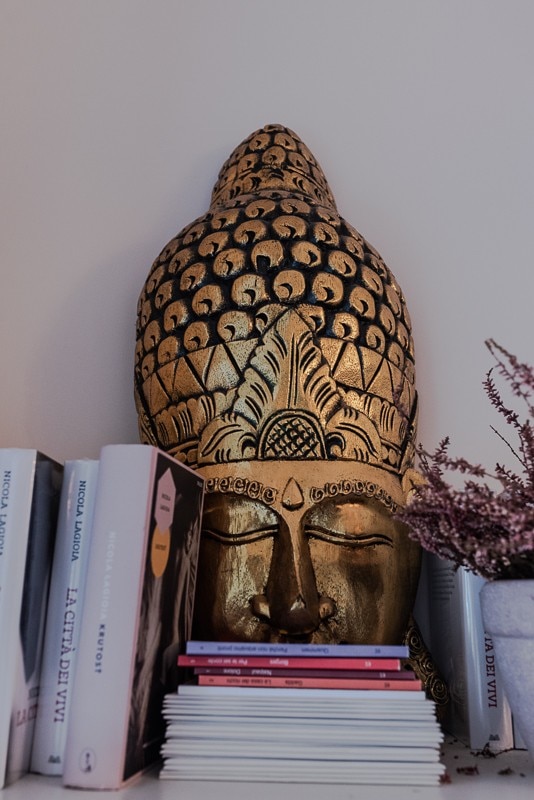“How do I explain to my wife that when I look out the window I’m working?” said Joseph Conrad, author of Heart of Darkness. But that’s certainly not the case with Nicola Lagioia. In his Roman home, which he shares with his wife, the writer Chiara Tagliaferri, no explanations are necessary because they both share the same profession. Of all the jobs and vocations, being a writer is one that by its very nature defies the separation of work and private life. “If my living space could be limited to Esquilino, I’d be content – I’m like a cat – and instead I’m often forced to leave”, reveals the Italian writer, radio host, and former director of the Salone Internazionale del Libro from 2017 until its latest edition.
Nicola has lived in this apartment since 2006, while Chiara joined him in 2007. “When my wife first stepped foot here, she started to cry because the house was completely empty, she could hear the echo of her voice. There was only a desk with a computer, stacks of books, a bed, and a table – a perfect meeting point between Beckett and Giacometti. In fact, the impression was perhaps that of an even more stripped-down existence”. The rooms gradually filled up, transitioning from what Lagioia fondly refers to as a somewhat “Lutheran view of life”, to the introduction of a porcelain jaguar that now sits in the lobby. “For Chiara, the jaguar is the bare minimum; she has more of a Wes Anderson aesthetic”.

 View gallery
View gallery
Nicola and Chiara’s apartment today has a welcoming and lively soul, made up of many presences: the countless titles that populate the shelves, the faces and voices from different cultures that appear here and there, from Gramsci to pop.
In the living-room-studio where Nicola spends most of his time, one’s gaze is drawn to small Mexican demons, a find from a recent trip: “When I go places, I always want to come home. This happens to me everywhere, except in Mexico”, that land of mysteries and legends, where Lagioia would have liked to get lost and “maybe even die”. “It felt like a great Puglia. In Mexico City, despite the warnings I had received, I found a much calmer atmosphere than in Bari in ‘87, in the working-class neighborhoods I largely frequented”.
Mexican folklore is full of rituals and sinister figures that vividly exorcise the concept of death and “evil”. Speaking of representations of “evil”, when meeting a writer whose narratives so sensitively touch certain abysses of the human experience, many questions arise; indeed, one’s curiosity is drawn to that anonymous apartment on Via Igino Giordani – a pivotal setting in Lagioia’s The City of the Living – where a ruthless horror unfolded through the tragic murder of Luca Varani.

“A good part of horror has a domestic quality; it’s hard to envision an exorcist en plain air. At the time of the event, I remember journalist Alessio Schiesari telling me that they were going there with the crew, and if I wanted to join them. I went, 4 days after the murder. Collatino is a rather transient area, and I distinctly remember arriving in front of a tall building – there are only a few like that in Rome. It was a mixed Ballardian/Shivers situation, where the psychogeography was already strange. No one had heard anything about the murder, yet I could hear the clinking of dishes being washed from the other side. When I got there, a sickening sensation washed over me. You feel it where there has been evil – much like animals sensing their impending slaughter; they just know”.
In the end, he never set foot inside the apartment. “I know it from the outside and from the photographs presented in the court documents. To cross that threshold would have felt like desecrating something”.
Violence is etched into our biological memory. We are bound to a food chain intimately connected to death. I find myself fascinated by plants that produce their own food through transformation.
Nicola Lagioia

In an almost absurd way, the apartment and its story have resided within Lagioia’s mind for a solid four years. “Now, I am completely out of it. Many authors experience this: once a book is written, that version of themselves becomes obsolete. You change world”. After all, as Lagioia aptly defined in an interview, a writer “is somewhere between a scientist and an exorcist. One is liberated from the stories shared with the world, that reside between the pages of a novel or in the boxes of court documents stacked high on a shelf. Yet, can we truly free ourselves from the narrative of evil? Perhaps complete liberation is impossible, for we remain entwined within the circle of life in which “to survive, we must destroy something”. Nicola observes, “Violence is etched into our biological memory. We are bound to a food chain intimately connected to death. I find myself fascinated by plants that produce their own food through transformation”.
Perhaps it is through the very act of storytelling that we find the means to process our experiences rather than perpetuate a cycle of harm. Indeed, the only thing we can try to do is to “reduce the damage. This is one of the missions to which we are called: to transform the violence within us”.








































